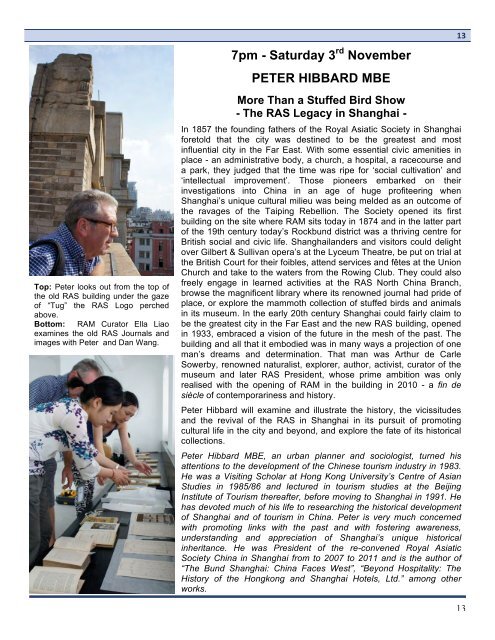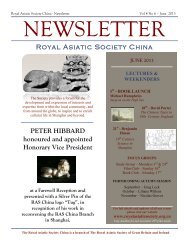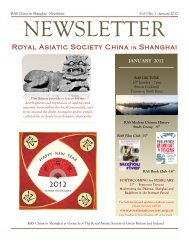Royal Asiatic Society China in Shanghai
Royal Asiatic Society China in Shanghai
Royal Asiatic Society China in Shanghai
You also want an ePaper? Increase the reach of your titles
YUMPU automatically turns print PDFs into web optimized ePapers that Google loves.
Top: Peter looks out from the top of<br />
the old RAS build<strong>in</strong>g under the gaze<br />
of “Tug” the RAS Logo perched<br />
above.<br />
Bottom: RAM Curator Ella Liao<br />
exam<strong>in</strong>es the old RAS Journals and<br />
images with Peter and Dan Wang.<br />
7pm - Saturday 3 rd November<br />
PETER HIBBARD MBE<br />
More Than a Stuffed Bird Show<br />
- The RAS Legacy <strong>in</strong> <strong>Shanghai</strong> -<br />
In 1857 the found<strong>in</strong>g fathers of the <strong>Royal</strong> <strong>Asiatic</strong> <strong>Society</strong> <strong>in</strong> <strong>Shanghai</strong><br />
foretold that the city was dest<strong>in</strong>ed to be the greatest and most<br />
<strong>in</strong>fluential city <strong>in</strong> the Far East. With some essential civic amenities <strong>in</strong><br />
place - an adm<strong>in</strong>istrative body, a church, a hospital, a racecourse and<br />
a park, they judged that the time was ripe for ‘social cultivation’ and<br />
‘<strong>in</strong>tellectual improvement’. Those pioneers embarked on their<br />
<strong>in</strong>vestigations <strong>in</strong>to <strong>Ch<strong>in</strong>a</strong> <strong>in</strong> an age of huge profiteer<strong>in</strong>g when<br />
<strong>Shanghai</strong>’s unique cultural milieu was be<strong>in</strong>g melded as an outcome of<br />
the ravages of the Taip<strong>in</strong>g Rebellion. The <strong>Society</strong> opened its first<br />
build<strong>in</strong>g on the site where RAM sits today <strong>in</strong> 1874 and <strong>in</strong> the latter part<br />
of the 19th century today’s Rockbund district was a thriv<strong>in</strong>g centre for<br />
British social and civic life. <strong>Shanghai</strong>landers and visitors could delight<br />
over Gilbert & Sullivan opera’s at the Lyceum Theatre, be put on trial at<br />
the British Court for their foibles, attend services and fêtes at the Union<br />
Church and take to the waters from the Row<strong>in</strong>g Club. They could also<br />
freely engage <strong>in</strong> learned activities at the RAS North <strong>Ch<strong>in</strong>a</strong> Branch,<br />
browse the magnificent library where its renowned journal had pride of<br />
place, or explore the mammoth collection of stuffed birds and animals<br />
<strong>in</strong> its museum. In the early 20th century <strong>Shanghai</strong> could fairly claim to<br />
be the greatest city <strong>in</strong> the Far East and the new RAS build<strong>in</strong>g, opened<br />
<strong>in</strong> 1933, embraced a vision of the future <strong>in</strong> the mesh of the past. The<br />
build<strong>in</strong>g and all that it embodied was <strong>in</strong> many ways a projection of one<br />
man’s dreams and determ<strong>in</strong>ation. That man was Arthur de Carle<br />
Sowerby, renowned naturalist, explorer, author, activist, curator of the<br />
museum and later RAS President, whose prime ambition was only<br />
realised with the open<strong>in</strong>g of RAM <strong>in</strong> the build<strong>in</strong>g <strong>in</strong> 2010 - a f<strong>in</strong> de<br />
siècle of contemporar<strong>in</strong>ess and history.<br />
Peter Hibbard will exam<strong>in</strong>e and illustrate the history, the vicissitudes<br />
and the revival of the RAS <strong>in</strong> <strong>Shanghai</strong> <strong>in</strong> its pursuit of promot<strong>in</strong>g<br />
cultural life <strong>in</strong> the city and beyond, and explore the fate of its historical<br />
collections.<br />
Peter Hibbard MBE, an urban planner and sociologist, turned his<br />
attentions to the development of the Ch<strong>in</strong>ese tourism <strong>in</strong>dustry <strong>in</strong> 1983.<br />
He was a Visit<strong>in</strong>g Scholar at Hong Kong University’s Centre of Asian<br />
Studies <strong>in</strong> 1985/86 and lectured <strong>in</strong> tourism studies at the Beij<strong>in</strong>g<br />
Institute of Tourism thereafter, before mov<strong>in</strong>g to <strong>Shanghai</strong> <strong>in</strong> 1991. He<br />
has devoted much of his life to research<strong>in</strong>g the historical development<br />
of <strong>Shanghai</strong> and of tourism <strong>in</strong> <strong>Ch<strong>in</strong>a</strong>. Peter is very much concerned<br />
with promot<strong>in</strong>g l<strong>in</strong>ks with the past and with foster<strong>in</strong>g awareness,<br />
understand<strong>in</strong>g and appreciation of <strong>Shanghai</strong>’s unique historical<br />
<strong>in</strong>heritance. He was President of the re-convened <strong>Royal</strong> <strong>Asiatic</strong><br />
<strong>Society</strong> <strong>Ch<strong>in</strong>a</strong> <strong>in</strong> <strong>Shanghai</strong> from to 2007 to 2011 and is the author of<br />
“The Bund <strong>Shanghai</strong>: <strong>Ch<strong>in</strong>a</strong> Faces West”, “Beyond Hospitality: The<br />
History of the Hongkong and <strong>Shanghai</strong> Hotels, Ltd.” among other<br />
works.<br />
13<br />
13














